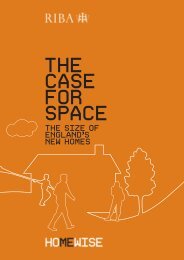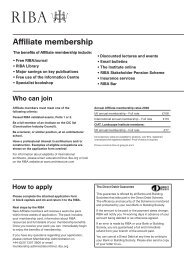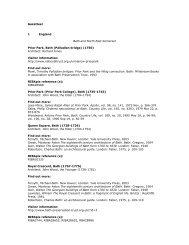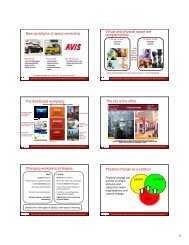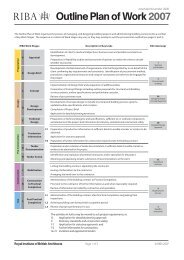Albertopolis Walking Tour: transcript - Royal Institute of British ...
Albertopolis Walking Tour: transcript - Royal Institute of British ...
Albertopolis Walking Tour: transcript - Royal Institute of British ...
You also want an ePaper? Increase the reach of your titles
YUMPU automatically turns print PDFs into web optimized ePapers that Google loves.
were possibly influenced in their choice <strong>of</strong> decoration by the University Museum, Oxford, by<br />
Deane & Woodward, which Waterhouse visited in 1858.<br />
All <strong>of</strong> the decoration and the whole façade facing are carried out in terracotta. Waterhouse<br />
chose this relatively new material since it could mass produce cheap, durable, and washable<br />
ornament.<br />
The overall result <strong>of</strong> the façade is reminiscent <strong>of</strong> both a cathedral front and a medieval<br />
market hall. The building is entered via a magisterial staircase and cathedral like portal, a<br />
theme which is continued in the grand entrance hall which resembles a large church nave.<br />
The interior <strong>of</strong> the museum is equally as decorative and beautiful as its exterior and is well<br />
worth exploring, even if you’re not interested in dinosaurs!<br />
Continue to walk eastwards along Cromwell Road towards the main entrance to the V&A.<br />
Pause the recording<br />
21. Victoria and Albert Museum<br />
47.22mins<br />
Before you is the world renowned<br />
Victoria and Albert Museum, however<br />
the museum began its life under a<br />
different name and in a different<br />
location. The first seed <strong>of</strong> what was to<br />
become the South Kensington<br />
Museum, and later the V&A, was the<br />
founding <strong>of</strong> the Government School <strong>of</strong><br />
Design, established in Somerset House<br />
in 1837. The Department <strong>of</strong> Practical<br />
Art followed in 1852 with the<br />
associated Museum <strong>of</strong> Manufactures set<br />
up in Marlborough House, which<br />
included objects purchased from the<br />
Great Exhibition.<br />
Aerial photograph <strong>of</strong> the Victoria and Albert<br />
Museum, 2002<br />
Copyright: English Heritage. NMR<br />
The result was the first public<br />
institution to <strong>of</strong>fer education in design,<br />
with the objective to make works <strong>of</strong> art<br />
available to all, and to inspire contemporary design. Both the department and museum were<br />
renamed in 1853, and in 1857 they moved to the site before you.<br />
Henry Cole became the museum’s first director, and it was he who coined the name South<br />
Kensington for both the area and the museum. The South Kensington Museum opened in<br />
the summer <strong>of</strong> 1857 to the north east <strong>of</strong> where you are standing, in a temporary iron building<br />
which earned the derogatory nickname the ‘Brompton Boilers.’ Cole quickly employed the<br />
engineer Captain Francis Fowke to design new permanent buildings for the museum<br />
collections. The Brompton Boilers was dismantled in 1864 and partially re-erected at Bethnal<br />
Green for a new museum, now the Museum <strong>of</strong> Childhood.<br />
22




